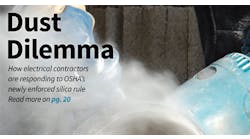Why can't you use the 90°C column of the ampacity tables in Chapter 3? Well, you can but only if every component (including connectors) is rated for a 90°C application [110.14(C)]. This generally means you can't use that column because connectors aren't typically rated for 90°C use, and your connectors and your cables are typically in the same ambient temperature space. To get a connector of adequate ampacity, you must use the larger conductors in the 60°C column. If you use a connector that fits the conductor in the 90°C column, the connector will be too small to handle the current thus imposed upon it.
So what's with the "generally" qualifier and why is there a 90°C column at all? Consider what you might do if a portion of the cable runs through a space that's heated due to the presence of steam pipes and there are no splices or connectors in that portion. This is exactly the scenario covered in Annex D, Example D3(a).
While Example D3(a) answers the 90°C question, it also illustrates several other important NEC concepts. Furthermore, it walks you through a series of example calculations, including motor loads. If you want to deepen your understanding of the NEC, spend time chewing on Example D3(a).


